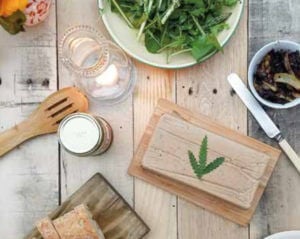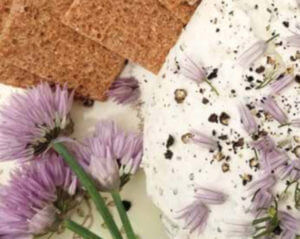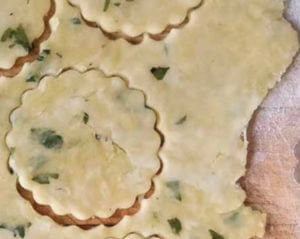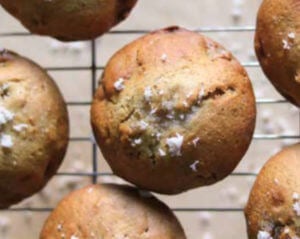Foraging Up the Perfect Fall Picnic
Sure, summer picnics are great, but have you ever dined al fresco under the vibrant colors of fall foliage? There’s something magical about the crisp autumn air and the radiant hues of oranges and yellows and reds. It’s a picture reminiscent of a quintessential New England town. But if that’s not enough to make you pack your basket immediately, why not make it even more memorable by planning a picnic menu based on delights foraged in the abundant nature that surrounds you?
The following recipes are from Forage, Harvest, Feast by Marie Viljoen. It has been adapted for the web.
Yogurt Cheese with Wild Herbs
Serves 8–10 as an appetizer
An Instagram posting by Danielle Prohom Olson—who forages on Vancouver Island in British Columbia—inspired what has become a spring favorite in my kitchen. My version is flavored with northeastern forages, wild salts, and young garlic pulled from the garden. You can use any seasonal herb salt and fresh herbs, but I love the emphasis of four species of allium, with a dash of ground elder, in this creamy, very spreadable cheese (technically, labneh, a drained yogurt). The better the yogurt you use, the better the result.
Ingredients
1 pound (453 g) Greek yogurt
2 tablespoons very finely chopped tender ground elder leaves
2 tablespoons finely snipped field garlic greens
1 tablespoon dried Salted Ramp Leaves
1 tablespoon chive flowers (separated into individual flowers)
2 tablespoons finely chopped green garlic (or ramp bulbs, or field garlic bulbs)
3⁄4 teaspoon Ramp Leaf Salt
1⁄2 teaspoon Ground Elder Salt
Procedure
- In a bowl combine all the ingredients and mix well.
- Place a double layer of cheesecloth in a strainer over another bowl.
- For decoration place some edible flowers or leaves—chives, mustard, sheep sorrel, dandelion—in the center of the cloth.
- Carefully spoon the yogurt mixture on top of them.
- Bring the corners of the napkin or cloth together and twist so that the yogurt is forced into a ball. Hold it there tightly for a few seconds, allowing some liquid to drip out. Undo the twist.
- Now gather the cloth tightly around the ball and tie off with kitchen twine.
- Transfer the wrapped yogurt in its strainer and bowl to the fridge.
- The cheese can be enjoyed after 4 hours but is much firmer after 12. Gently remove its cloth wrapping and turn it out onto a serving board or plate.
- Serve with crackers, on toast, with Nettle and Ramp Biscuits and a slick of honey, or in a fresh salad.
Makes 6 pots, ½ cup (125 ml) each.
This mousse is light and silky in texture, and quick to assemble. If you use cream that has an additive like carrageenan in it, do not be worried by the weirdly gelatinous texture of the mixture after blending. But do try to find cream that is just cream (harder than it sounds). You can also substitute Sweetfern Bourbon or Bayberry Beach Plum Gin for the Elderberry Gin. Serve with good toast or bread and a relish of Field Garlic Marmalade, Juniper Black Currant Chutney, or Fermented Elderberry Capers.
Ingredients
4 ounces (113 g) butter, melted 
1 pound (453 g) chicken livers, cleaned
2 large egg yolks
5 fluid ounces (150 ml) cream
1 teaspoon salt
3 tablespoons Elderberry Gin Sweetfern leaves (optional)
Procedure
Preheat the oven to 300°F (150°C).
For individual servings:
- Combine all the ingredients and blend until very smooth (you may have to do this in two batches).
- If you are using sweetfern, place a leaf in the bottom of each ramekin.
- Pour the mixture into six 1⁄2-cup (125 ml) ramekins until they’re three-quarters full.
- Place a large skillet or baking pan in the oven. Place the ramekins in it.
- Fill the pan with hot water until it reaches two-thirds of the way up the ramekins’ sides.
- Place a large sheet of parchment or foil over the top of the ramekins to protect the mousse from the oven’s hot air.
- Bake for 30 to 35 minutes, or until the mousse is firm and does not jiggle wildly in the middle when you give it a firm jab. Ideally, you’re looking for a barely discernible shiver.
- Once the mousses are cool, chill them in the fridge, keeping them covered.
- Either serve them straight from the pot, or unmold them: Dip a knife in just-boiled water and slide it around the inner edge of each ramekin.
- Cover with a small serving plate or board and invert. Serve cool.
Variation, for a single, sliceable mousse:
- Instead of using ramekins, pour all the mousse mixture into a baking pan or terrine approximately 81⁄2 by 41⁄2 inches (22 × 11 cm). Remember to line it with sweetfern leaves, if using, before you pour.
- Place in the bain-marie as above, and cover with parchment or foil. You will need a longer bake, about an hour.
- It is done when a skewer inserted all the way comes out clean.
- Once cool, follow the chilling and serving instructions above.
Makes about 40 crackers.
One of the most adaptable pastries I use is this olive oil recipe that makes a crisp base for countless pies and tarts. Rolled out even more thinly, it yields excellent crackers (as I discovered one day when babysitting friends’ young sons, who were bored—we baked them together, and they wolfed them hot from the oven). Serve with Yogurt Cheese with Wild Herbs, Roasted Elderflower Carrot Pâté, or Garlic Mustard with Pecans.
Ingredients
21⁄4 cups (180 g) flour
1⁄2 cup (125 ml) extra-virgin olive oil
1⁄2 cup (125 ml) tepid water
2 tablespoons finely chopped mugwort
1 teaspoon Mugwort Salt
1 tablespoon butter
Procedure
- Combine all the ingredients except the butter in a mixing bowl and mix well.
- For ease of rolling, divide the dough into two fat disks, wrap, and chill for 30 minutes (it will never get completely hard).
- Melt the butter and brush a baking sheet. Place the sheet in the freezer to chill.
- Preheat the oven to 400°F (200°C).
- Roll the pastry out on a floured board as thinly as possible.
- Now either press out crackers using a cookie cutter, or use a knife or pizza blade to hand-cut 21⁄2-inch (6 cm) squares or rounds. Lift them carefully to the baking sheet.
- Bake until their edges are deeply golden, about 12 to 15 minutes.
- Transfer to a wire cooling rack. Once they’re cool, store in an airtight container and eat within 2 days, or freeze.
Makes 1 large cake or 8 small cakes.
The color of turning leaves, this aromatic cake has autumn written all over it. While you can bake it in a round or square 8- or 9-inch (20–23 cm) pan, I like to make individual cakes as holiday gifts, baking them in pans with six slots each 3¾ inches (9½ cm) wide. Chestnut honey is ideal here, but it is mouth-melting with any honey and can be made with molasses, too. I can seldom resist breaking one open, warm from the oven, and spreading it with butter. They are denser the next day, but still wonderful.
Ingredients
4 ounces (113 g) hoshigaki
3 tablespoons bourbon
1⁄4 cup (60 ml) water
1 cup (250 ml) dark honey
1 cup (250 ml) boiling water
4 ounces (113 g) butter
1⁄2 cup (100 g) sugar
1 large egg
21⁄2 cups (300 g) flour
11⁄2 teaspoons baking soda
1⁄2 teaspoon salt
2 teaspoons ground spicebush
1 teaspoon powdered mustard
1 teaspoon cattail pollen
1 tablespoon Sumac Sugar, for brushing 1 tablespoon water, for brushing
Procedure
Preheat the oven to 350°F (180°C). Lightly butter your cake pan or pans.
For the persimmons:
- Remove the dry stems and calyxes from the hoshigaki.
- Place them in a small bowl with the bourbon and water. Cover.
- Allow them to soak for 12 hours, turning them once so that the top fruit get a soaking, too.
- After they have absorbed all or most of the liquid, chop them into small pieces. The centers may still be tough, so watch your fingers.
For the cake:
- In a jug or small bowl, mix together the honey and boiling water; stir to dissolve the honey.
- In a bowl cream the butter and sugar until light and fluffy. Beat in the egg.
- Gradually add the dry ingredients, alternating with the honey-water. Mix well.
- Stir in the persimmons.
- Pour the fairly loose batter into the prepared pan or pans.
- Transfer to the hot oven.
- For a large cake bake about 35 minutes; for the smaller cakes, 18 to 20 minutes.
- An inserted skewer must come out clean.
- Turn them out carefully.
- Mix the Sumac Sugar and water and brush this over the tops of the cakes quickly while hot.



